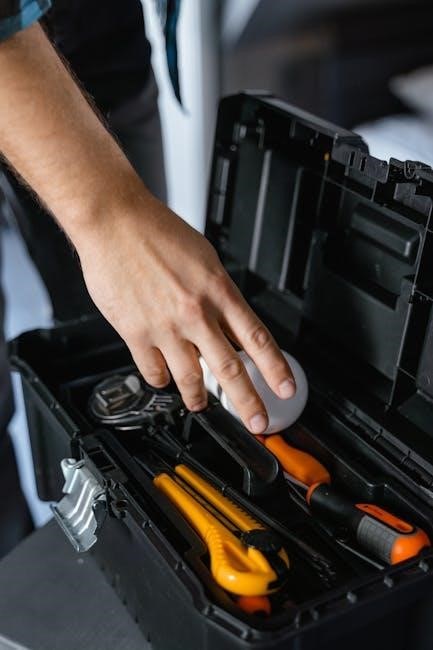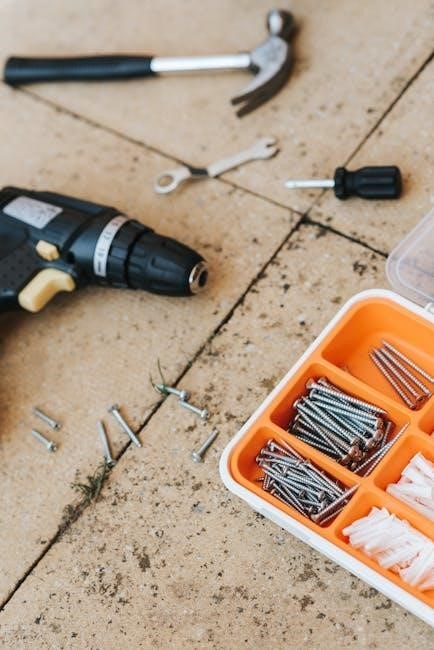Welcome to the Leslie 25 Manual, your comprehensive guide to understanding and optimizing the Leslie 25 speaker system․ This manual is essential for users seeking to unlock its full potential, ensuring optimal performance and longevity through detailed instructions and expert advice․
Overview of the Leslie 25 Speaker System
The Leslie 25 is a high-quality speaker system designed to enhance audio performance, particularly for Hammond organs and similar instruments․ Known for its robust design and advanced features, it offers exceptional sound reproduction with clarity and depth․ The system is popular among musicians and audio enthusiasts due to its reliability and versatility․ Its compatibility with various Hammond models makes it a preferred choice for those seeking professional-grade sound․ The Leslie 25 is built to deliver consistent performance, ensuring an immersive audio experience for both performers and audiences alike․
Importance of the Leslie 25 Manual for Users
The Leslie 25 Manual is an indispensable resource for users, providing detailed instructions for installation, operation, and maintenance․ It ensures proper setup and troubleshooting, maximizing system performance and longevity․ The manual offers insights into optimizing sound quality and resolving common issues, catering to both novice and experienced users․ By following its guidelines, users can enhance their audio experience and maintain the system’s peak condition․ This comprehensive guide is essential for anyone aiming to fully utilize the Leslie 25’s capabilities and enjoy uninterrupted, high-quality sound reproduction․

Key Features of the Leslie 25
The Leslie 25 boasts advanced sound processing, durable construction, and user-friendly controls, ensuring exceptional audio quality and reliability․ Its design enhances performance and versatility for various applications․
Technical Specifications and Capabilities
The Leslie 25 features a robust amplifier delivering clear, resonant tones, with a frequency response optimized for organic sound reproduction․ Its compact design allows seamless integration with Hammond organs, while advanced circuitry ensures stable operation․ The system supports multiple speaker configurations, making it versatile for various setups․ Built with high-quality components, it offers durability and consistent performance․ These technical capabilities make the Leslie 25 a reliable choice for musicians seeking professional-grade audio output and long-term reliability․
Unique Design Elements of the Leslie 25
The Leslie 25 boasts a distinctive design that combines functionality and aesthetics․ Its compact, lightweight cabinet is crafted for portability, while the rotating horn and drum system produces the signature Leslie sound․ The system includes a motorized rotor for dynamic tonal variations, enhancing expressiveness․ The control panel offers intuitive adjustments, allowing users to tailor resonance and tone to their preference․ These innovative design elements contribute to the Leslie 25’s reputation as a versatile and high-quality speaker system, ideal for both studio and live performances․

Installation and Setup
Place the Leslie 25 on a flat surface, ensuring stability․ Connect the necessary cables securely, following the manual’s wiring diagram․ Power on the system and test functionality․
Step-by-Step Installation Instructions
Begin by carefully unpacking the Leslie 25 and inspecting all components for damage․ Place the unit on a stable, flat surface, ensuring proper ventilation․ Connect the power cord to a grounded outlet․ Next, attach the speaker cables to the appropriate terminals, following the wiring diagram in the manual․ If connecting to a Hammond organ, use the recommended adapter and ensure secure connections․ Finally, power on the system and perform a test to verify proper operation; Refer to the manual for specific diagrams and troubleshooting tips to ensure a smooth setup process․
Connecting the Leslie 25 to Hammond Organs
Connecting the Leslie 25 to Hammond organs requires the use of the correct adapter, such as the 27-1, to ensure compatibility and optimal performance․ Begin by locating the appropriate connection ports on both the Leslie 25 and the Hammond organ․ Carefully attach the adapter to the organ’s interface, following the wiring diagram provided in the manual․ Securely connect the other end to the Leslie 25’s input terminals․ Ensure all connections are tight to avoid signal loss․ Once connected, test the system to confirm proper functionality․ Refer to the manual for specific instructions and troubleshooting tips to achieve the best sound quality․

Operating the Leslie 25
Mastering the Leslie 25 involves understanding its control panel, which features speed and volume adjustments․ Familiarize yourself with its intuitive interface to customize your sound experience effectively․
Understanding the Control Panel and Functions
The Leslie 25 control panel is designed for intuitive operation, featuring essential knobs and switches․ The speed control adjusts the Leslie’s signature rotor effect, while the volume knob manages output levels․ A power switch is included for easy startup and shutdown․ Additional controls may include settings for bass and treble, allowing precise tone customization․ Familiarizing yourself with these functions ensures you can tailor the sound to your preferences․ Always refer to the manual for detailed instructions on optimizing these settings for the best performance․
Optimizing Sound Quality and Performance
To achieve the best sound quality from your Leslie 25, proper placement and setup are crucial․ Position the speaker in a room with ample space to allow the rotors to project sound effectively․ Adjust the speed and volume controls to match your musical style, ensuring a balanced tone․ Regularly clean the rotors and check for dust buildup to maintain clarity․ Experiment with the bass and treble settings to tailor the sound to your preferences․ For optimal performance, ensure all connections are secure and avoid overloading the system․ Refer to the manual for specific guidelines on maximizing your Leslie 25’s potential․

Troubleshooting Common Issues
Identify and resolve common problems with the Leslie 25, such as motor noise or connectivity issues, by consulting the manual for detailed diagnostic and repair guidance․
Diagnosing and Resolving Technical Problems
When encountering issues with the Leslie 25, start by identifying symptoms like unusual noise or connectivity problems․ Consult the manual for troubleshooting guides tailored to specific faults․ Check connections and ensure proper installation, as outlined in the Leslie 25 manual․ For motor or amplifier issues, refer to diagnostic charts and repair steps․ Clean components and replace worn parts as needed․ Adjust settings according to the manual’s instructions to restore optimal performance․ If problems persist, seek assistance from expert forums or professional technicians․ Regular maintenance and adherence to the manual’s guidelines can prevent many technical issues․
Common Errors and Their Solutions
Common issues with the Leslie 25 include improper amplifier connections and faulty motor operations․ Ensure all cables are securely attached and verify settings match the manual’s specifications․ For motor malfunctions, check for obstructions or worn belts and replace them if necessary․ If the speaker produces distorted sound, adjust the equalization settings or clean the components․ Refer to the troubleshooting section for detailed solutions․ Regular maintenance, as outlined in the manual, can prevent many of these issues, ensuring smooth and optimal performance of your Leslie 25 speaker system․

Maintenance and Repair
Regular maintenance ensures the Leslie 25’s longevity․ Clean components, check connections, and inspect moving parts․ For complex repairs, consult the manual or seek professional assistance․
Routine Maintenance Tips for Longevity
To ensure the Leslie 25 operates at peak performance, regular maintenance is crucial․ Dust the speaker grills and internal components monthly to prevent buildup․ Check all electrical connections for stability and cleanliness․ Lubricate moving parts like the motor bearings every six months to maintain smooth operation․ Avoid exposing the system to extreme temperatures or humidity․ Finally, refer to the manual for specific guidance on replacing worn components and updating firmware to keep your Leslie 25 sounding its best for years to come․
Advanced Repair Techniques for the Leslie 25
For advanced repairs, diagnosing issues like amplifier hum or motor misalignment requires specialized tools and expertise․ Refer to the Leslie 25 service manual for detailed schematics and repair procedures․ Replace faulty capacitors or transistors carefully, ensuring soldering meets high standards․ Motor recalibration may involve adjusting bearings or rebalancing the rotor․ For complex issues, consulting the Leslie 25 manual or seeking advice from experienced technicians is recommended․ Always use genuine replacement parts to maintain performance and reliability, ensuring your Leslie 25 operates at its best for years to come․

Resources and Support
Access the Leslie 25 manual online through official Leslie websites or platforms like eBay and the Internet Archive․ Community forums offer expert advice and troubleshooting tips, while service centers provide professional assistance for complex repairs, ensuring comprehensive support for your Leslie 25 speaker system․
Where to Find the Leslie 25 Manual Online
The Leslie 25 manual is available for download on various online platforms․ Official Leslie websites, eBay, and the Internet Archive offer PDF versions of the manual․ Additionally, forums and communities dedicated to Hammond organs and Leslie speakers often share links to the manual․ Some users have also uploaded the manual to file-sharing sites, making it easily accessible․ Ensure you verify the authenticity of the source before downloading․ This convenient access allows users to reference the manual anytime, ensuring proper setup, operation, and maintenance of the Leslie 25 system․
Community Forums and Expert Advice
Engaging with community forums and expert advice is invaluable for Leslie 25 users․ Dedicated forums and groups discuss various Leslie models, including the 25, offering tips, troubleshooting, and shared experiences․ Experts and enthusiasts often provide detailed solutions and insights, complementing the manual․ These platforms are ideal for addressing unique issues or seeking advice on customization and maintenance․ By participating in these communities, users can gain deeper understanding and optimize their Leslie 25 performance effectively․
The Leslie 25 Manual serves as a comprehensive guide, helping users master its features and troubleshooting․ Explore further to maximize your experience with this iconic speaker system․
Final Thoughts on the Leslie 25 Manual
The Leslie 25 Manual is a vital resource for users, offering detailed insights into installation, operation, and maintenance․ It ensures optimal performance and longevity of the system․ By following the guidelines, users can troubleshoot common issues and enhance sound quality effectively․ The manual’s comprehensive approach makes it indispensable for both beginners and experts․ With its clear instructions and expert advice, it empowers musicians and technicians to fully utilize the Leslie 25’s capabilities․ Explore further to unlock its full potential and elevate your musical experience with this iconic speaker system․
Encouragement for Further Exploration
Exploring the Leslie 25 Manual is just the beginning of your journey with this iconic speaker system․ Dive deeper into its capabilities by experimenting with sound settings and connecting it to various Hammond organs․ Join community forums to share experiences and gain insights from fellow users and experts․ Regularly check online resources for updates and additional guides․ Embrace the opportunity to refine your skills and uncover the full potential of the Leslie 25․ Continuous learning and experimentation will enhance your musical creations and ensure you get the most out of this exceptional system․



























































